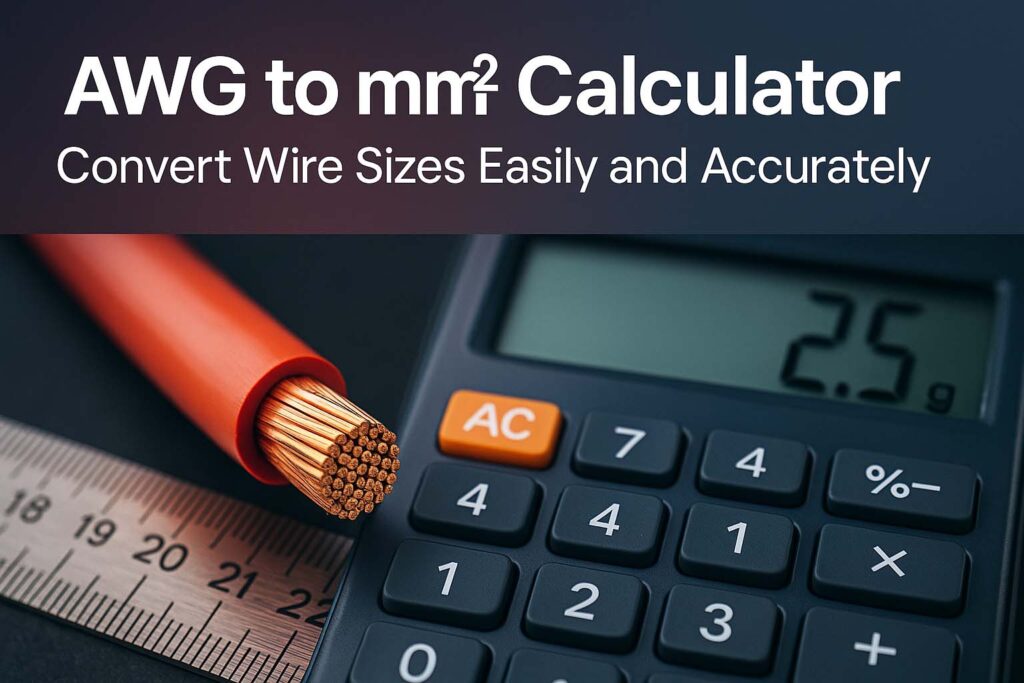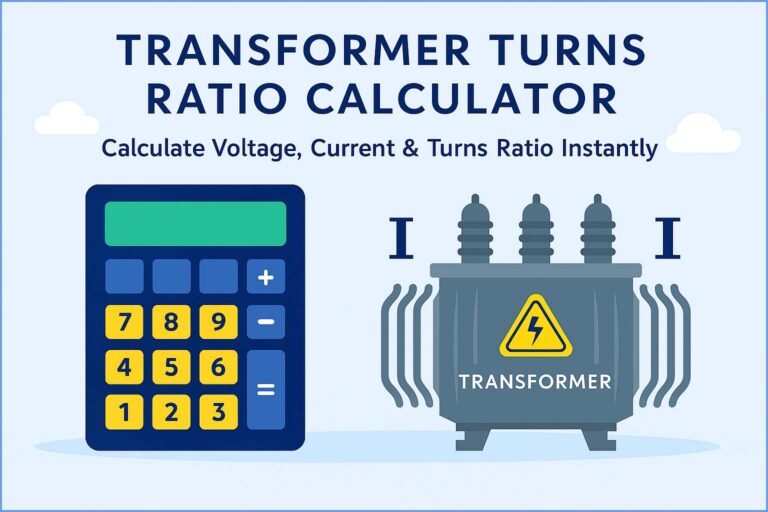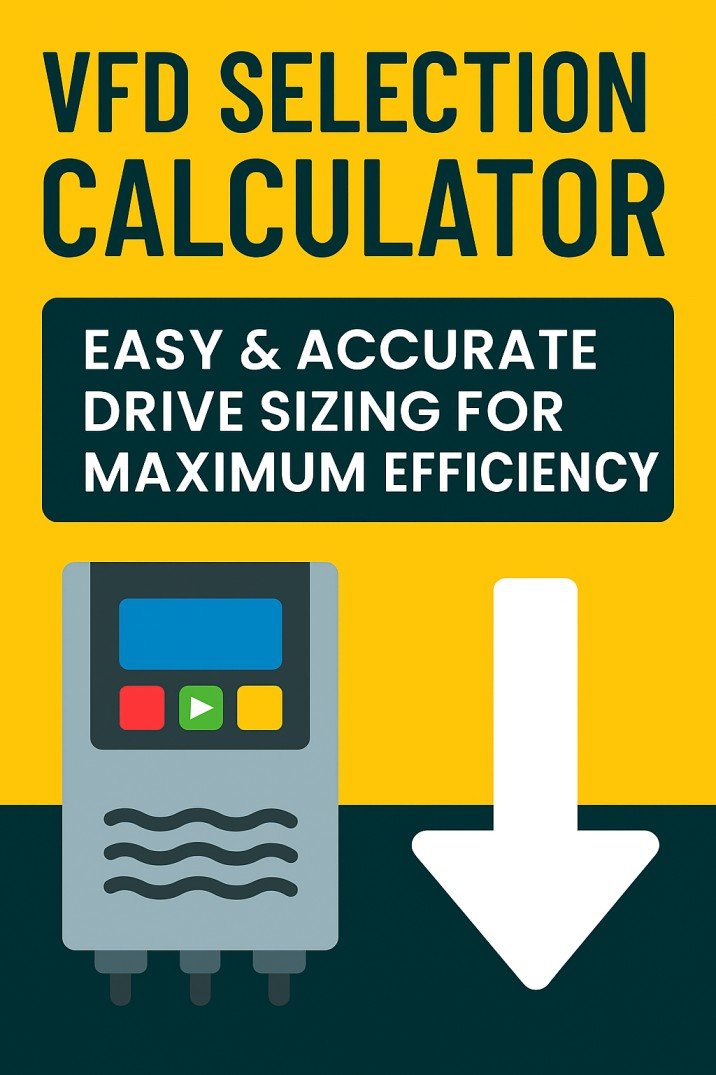AWG to mm² Calculator – Convert Wire Sizes Easily and Accurately
Choosing the right wire size is a crucial step in any electrical project. Whether you are working on a home wiring upgrade, a solar system installation, or industrial automation, wire gauge conversion is often required. This is where an AWG to mm² Calculator becomes essential. It helps you quickly convert American Wire Gauge (AWG) values into square millimeters (mm²), ensuring proper wire sizing, safe operation, and regulatory compliance.
Table of Contents
Table of Contents

In many parts of the world, AWG is a common standard, especially in North America. However, in countries that follow the metric system, wires are usually labeled in mm². This mismatch can confuse even experienced electricians. That’s why knowing how to convert between AWG and mm²—and using a reliable AWG to mm² Calculator—can make your work faster, safer, and more precise.
The difference between these two units is not just a matter of labeling. AWG is a logarithmic scale, while mm² is a direct area measurement. As AWG numbers increase, the wire diameter decreases, which is counterintuitive for beginners. Conversely, mm² is linear and easier to visualize.
Key Takeaways:
• AWG is used mostly in the US, while mm² is used globally
• A calculator simplifies the wire gauge conversion process
• Proper wire sizing prevents voltage drop and overheating
• Using the wrong wire size can cause circuit failure or fire risk
• Conversion tables and formulas are helpful but time-consuming; an online calculator saves time
Understanding AWG and mm² Wire Sizes
The American Wire Gauge (AWG) system was developed in the 1850s and has since been used to define the diameter and current-carrying capacity of electrical wires in North America. AWG is a standardized system based on wire diameter, not cross-sectional area. The gauge scale runs inversely—lower numbers mean thicker wires. For example, a 4 AWG wire is much thicker than a 16 AWG wire.
In contrast, square millimeters (mm²) directly represent the cross-sectional area of a conductor. This is the standard unit in most international electrical codes, including IEC and ISO standards. It is more intuitive because a 10 mm² wire has exactly twice the area of a 5 mm² wire.
This difference in unit representation leads to confusion when engineers or technicians are sourcing materials across borders. That’s why a wire gauge conversion calculator is not just helpful—it’s necessary.
Use our online tool Electrical Conduit Fill Calculator and Conduit Wire Fill Chart
Why Use an AWG to mm² Calculator?
Manually converting AWG to mm² involves complex formulas that can lead to errors. While tables exist, they are often cumbersome to use on the go or in field environments. An AWG to mm² Calculator offers the following benefits:
- Speed: You get instant results without looking up tables or doing math.
- Accuracy: Removes the possibility of manual errors.
- Convenience: Works on mobile devices, which is ideal for site engineers and electricians.
- Standardization: Helps maintain compliance with international electrical codes.
If you’re designing a power distribution board, running cable trays in a solar plant, or specifying wires for an EV charger, this tool helps you choose wires that handle current properly while minimizing voltage drop.
AWG to mm² Conversion Formula and Table
While a calculator does the job instantly, it’s useful to understand the math behind it. The formula to convert AWG to diameter in mm is:
Diameter (mm) = 0.127 × 92^((36 – AWG)/39)
To convert diameter to mm² (area), use:
Area (mm²) = (π / 4) × (Diameter)²
But let’s face it—nobody wants to do this every time. That’s where a ready table and calculator help. Here’s a quick reference electrical wire gauge chart:
Use our online tool Short Circuit Current Calculator for Transformers: Best Tool
| AWG Size | Diameter (mm) | Area (mm²) |
|---|---|---|
| 4 | 5.19 | 21.15 |
| 6 | 4.11 | 13.30 |
| 8 | 3.26 | 8.37 |
| 10 | 2.59 | 5.26 |
| 12 | 2.05 | 3.31 |
| 14 | 1.63 | 2.08 |
| 16 | 1.29 | 1.31 |
| 18 | 1.02 | 0.82 |
| 20 | 0.81 | 0.52 |
This table is handy but limited. A wire diameter conversion tool allows you to input any AWG size, even decimal or fractional gauges, and instantly get the mm² value with high accuracy.
Use our online tool Conduit Fill Calculator (NEC Standard) – Understand Conduit Fill and Wire Capacity
How an AWG to mm² Calculator Works
Most online calculators are based on the mathematical formulas and conversion standards discussed above. They generally include:
- A dropdown or input box for selecting AWG size
- Auto-calculated outputs for diameter (mm), area (mm²), and possibly resistance per meter
- Sometimes, reverse conversion from mm² to AWG
Some advanced versions even allow you to enter temperature ratings or insulation types, adjusting the recommendation accordingly. This is useful when selecting cables for high-current or high-temperature applications.
Use Cases for Wire Gauge Conversion
- Solar Panel Installations: International solar panels often use mm² cable specifications, but the inverter might list AWG wires.
- Automotive and EV Applications: EV chargers designed in the EU may need conversion to AWG for US installations.
- Building Wiring Projects: Converting local (mm²) wiring standards to match imported control panels or vice versa.
- Marine and Aerospace Wiring: These often use AWG even outside the US; conversion helps ensure safe capacity limits.
In each case, mismatched wire sizes can lead to underperformance, overheating, or regulatory failure. That’s why the AWG to mm² Calculator is more than a convenience—it’s a safety tool.
Common Mistakes to Avoid During Wire Conversion
Even with a calculator, you should be cautious about these mistakes:
- Ignoring insulation thickness: AWG and mm² refer only to conductor size, not the full wire diameter.
- Overloading smaller wires: Misreading gauge sizes can cause a wire rated for 10A to carry 20A—leading to fire risk.
- Assuming exact equivalence: Some AWG sizes fall between mm² sizes. In such cases, always round up to the next higher mm².
- Disregarding local codes: Always confirm if the installation code requires wire size in AWG or mm²—do not mix without proper labeling.
Use our online tool House Wiring Cable Size Calculator – Safe and Efficient Sizing for Home Circuits
How to Choose the Right Wire Size
Once you have used the wire size converter, apply the result to your wiring design. Remember, wire selection is not just about cross-section. It also depends on:
- Length of the wire run (longer runs need thicker wires)
- Voltage drop allowance
- Current load
- Ambient temperature
- Installation method (duct, conduit, underground)
Using the calculator only gives you the physical size. You must still match this with your application’s specific requirements. For instance, a 2.5 mm² wire may be fine for 20A in a short run, but for a 30-meter run, you might need 4 mm² to prevent voltage drop.
Use our online tool Short Circuit Current Calculator for Motors – Accurate Fault Current Calculation Guide
Final Thoughts on Using an AWG to mm² Calculator
Wire sizing might seem like a small part of an electrical project, but it affects everything from system safety to performance. A simple error in size selection can lead to inefficiency, overheating, or even dangerous failures.
Using an cable cross-section calculator removes guesswork, speeds up design time, and ensures global compatibility. Whether you’re a professional electrician or a hobbyist, this tool helps you make smart, safe, and code-compliant decisions.
Follow Us on Social:
Subscribe our Newsletter on Electrical Insights for latest updates from Electrical Engineering Hub
#AWGtoMM2, #WireSizeCalculator, #ElectricalWiring, #CableSizeConverter, #WireGaugeConversion, #AWGConversion, #ElectricalCalculator, #WireSizing, #CableEngineering, #ElectricalTools, #AWGChart, #MM2Converter, #ElectriciansToolbox, #VoltageDropCalculator, #HomeWiringHelp
AWG to mm² Calculator – Convert Wire Sizes Easily and Accurately : Electrical Engineering Hub

Choosing the right wire size is a crucial step in any electrical project. Whether you are working on a home wiring upgrade, a solar system installation, or industrial automation, wire gauge conversion is often required. This is where an AWG to mm² Calculator becomes essential. It helps you quickly convert American Wire Gauge (AWG) values into square millimeters (mm²), ensuring proper wire sizing, safe operation, and regulatory compliance.
Price Currency: USD
Operating System: All
Application Category: UtilitiesApplication






